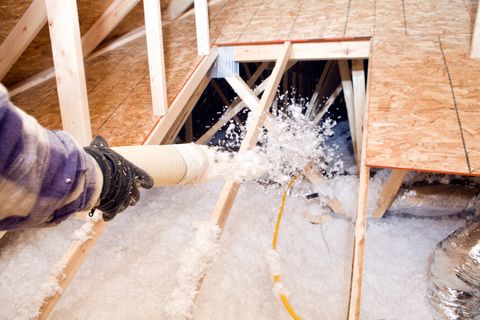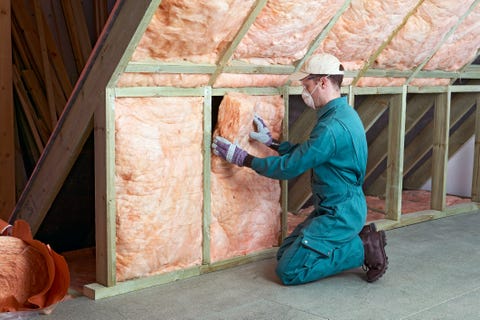How to Choose the Attic Insulation Your Home Needs
It all starts with the R-value.
By Timothy Dahl
GETTY IMAGES/BANKSPHOTOS
Proper attic insulation is the best way to prevent heat loss in the winter and retain cool air in the summer. So it's time to pay close attention to what's happening up there.
If you feel like your house is leaking money via a drafty or unsealed attic, conduct an energy audit and/or use a thermal camera to find cool spots up there. It's possible to fill those holes though, depending on the age of your insulation, you might be better off replacing your attic insulation outright instead of filling in the gaps.
Let's Talk R-Value
To start off, determine what R-value is recommended for your home based on your location. You can find this information from the Department of Energy. If you aren't familiar with R-value, it's basically an insulating material's resistance to heat flow, measured by its thermal resistance or R-value. The higher the R-value, the more effective an insulating material is. Your home's R-value score will guide you toward the type of insulation you need.
In general, an attic's R-value should be between R-30 and R-49. In particularly cold climates, you might go up to R-60. Let's say the insulation you've selected has an R-value of three per inch and you'd like to achieve an overall value of R-36. You'll need about 12 inches of insulation material.
Here are the most popular options for attic insulation, along with a ballpark figure on pricing.
Blanket Insulation

GETTY IMAGES/GARY OMBLER
Blanket insulation is available as batts or rolls and is the easiest DIY insulation material. It's available in fiberglass, mineral wool, plastic fibers, and natural fibers. This type of insulation is ideal for attics with standard spaced beams and joists and very few obstructions.
Batts must be carefully trimmed to fit snugly around vents to retain their R-value effectiveness. Pricing can vary based on thickness and material, but it's generally 0.15 to 0.50 cents per square foot. You can expect an R-value of 3.1 to 3.8 per inch.
Loose-Fill Insulation

GETTY IMAGES/BANKSPHOTOS
Loose-fill insulation is great for installing in attics with very little headroom and multiple obstructions such as vents and cross-beams. It can be effectively blown over existing insulation and is available in fiberglass, cellulose, and mineral wool. Cellulose is the most effective material and has an R-value of 2.2 to 3.8 per inch, but if exposed to moisture it can get moldy.
This type of insulation can be purchased online or at Home Depot and spread manually, or you can rent an easy-to-use machine that blows it in place, which will cost about $100 per day. Rental is often included for free if you purchase a minimum amount of insulation. If you hire a pro, it costs about $1 per square foot.
Sprayed Foam Insulation

GETTY IMAGES/C12
This type of insulation is expensive and not a do-it-yourself project, but it has one of the highest R-values at 3.5 per inch for open-cell and 6.5 for closed-cell.
Both types are made with polyurethane. The difference is that closed-cell foam cells are filled with a gas that helps the foam expand to fill the spaces around it. Open-cell foam cells are filled with air, which gives the insulation a spongy texture. Both types of insulation provide an effective air barrier, but closed-cell insulation can also serve as a moisture vapor barrier if that is needed.
Open-cell spray-foam insulation is roughly $1 to $1.25 per square foot and closed-cell spray foam is about $1.25 to $1.50 per square foot.
Good to know spray foam insulation. Its the basic element of a healthy home. These insulation tips given in the article are so prominent. Heating and Cooling Milton
ReplyDelete